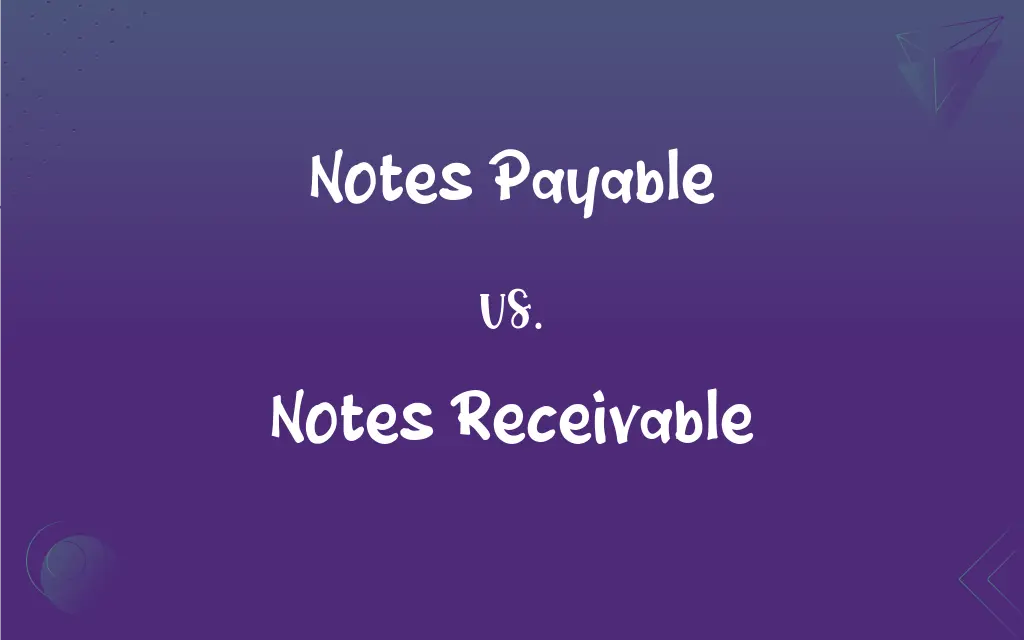Notes Payable vs. Notes Receivable: What's the Difference?
Edited by Aimie Carlson || By Harlon Moss || Published on January 4, 2024
Notes Payable refers to debts or obligations a company owes, to be paid in the future. Notes Receivable refers to amounts others owe to the company, to be received in the future.

Key Differences
Notes Payable represent a company's written promise to pay a debt. Notes Receivable are financial assets, indicating the company is owed money.
Notes Payable are recorded as liabilities on a company's balance sheet. Notes Receivable are recorded as assets, expected future cash inflows.
Notes Payable often involve interest to be paid by the company. Notes Receivable typically earn interest for the company.
Notes Payable are created when a company borrows money or purchases goods on credit. Notes Receivable are created when a company extends credit to customers or others.
Managing Notes Payable is crucial for a company's cash flow planning. Effectively handling Notes Receivable is key to ensuring healthy cash inflows.
ADVERTISEMENT
Comparison Chart
Definition
Debts a company owes to others
Amounts others owe to the company
Financial Statement
Recorded as liabilities
Recorded as assets
Interest Component
Usually involve paying interest
Typically involve earning interest
Creation
Arise from borrowing or credit purchases
Result from extending credit to customers
Impact on Cash Flow
Affect outflows and need careful management
Affect inflows and require efficient collection
ADVERTISEMENT
Notes Payable and Notes Receivable Definitions
Notes Payable
Written agreements to pay a specified amount at a future date.
The company's notes payable included a loan from the bank.
Notes Receivable
Claims or rights to receive payments from debtors.
The increase in notes receivable showed more customers buying on credit.
Notes Payable
A formal promise by a company to pay a debt.
The notes payable on their balance sheet were a result of recent expansions.
Notes Receivable
Assets representing money owed to the company.
The company's notes receivable were evidence of its strong sales on credit terms.
Notes Payable
Legal documents representing a company's debt.
Their notes payable increased after purchasing new equipment on credit.
Notes Receivable
Written promises for amounts to be received.
Their notes receivable included amounts owed by several corporate clients.
Notes Payable
Financial commitments to repay borrowed funds.
They negotiated the terms of their notes payable to manage cash flow.
Notes Receivable
Claims for future cash inflows from credit sales.
Effective management of notes receivable was crucial for their liquidity.
Notes Payable
Obligations to pay debts in a specified period.
The notes payable were due within the next two years.
Notes Receivable
Legal documents indicating a right to future payments.
Notes receivable often include interest, increasing their value over time.
FAQs
What role do notes receivable play in a company's finances?
They are crucial for cash inflows and asset management.
What are notes payable?
Legal documents indicating a company's obligation to pay a debt.
What are notes receivable?
Financial assets representing money owed to a company.
How do notes payable affect a company’s financial health?
They impact cash flow and liabilities, requiring careful management.
Are notes payable considered short-term liabilities?
They can be both short-term or long-term, depending on the repayment period.
What happens if notes payable are not repaid on time?
It can lead to default, affecting credit ratings and incurring penalties.
Do notes payable always involve interest payments?
Often, but not always; it depends on the terms of the agreement.
Can notes receivable be sold?
Yes, they can be sold or factored for immediate cash.
What factors influence a company's notes payable?
Borrowing needs, credit terms, and interest rates.
Why might a company prefer notes receivable to immediate payment?
To facilitate larger sales or maintain customer relationships.
Can notes receivable impact a company’s liquidity?
Yes, efficient collection of notes receivable improves liquidity.
Can individuals have notes payable and receivable?
Yes, in personal loans or other credit arrangements.
What is the difference in risk between notes payable and receivable?
Notes payable represent a risk of debt, while notes receivable carry the risk of non-payment.
Can notes payable be renegotiated?
Sometimes, depending on the lender's policies and the borrower's situation.
How are notes receivable recorded in accounting?
As assets on the balance sheet.
How do interest rates affect notes payable?
Higher interest rates increase the cost of borrowing.
How do notes receivable benefit a company?
By providing a source of future cash inflows and earning interest.
How are notes payable and receivable reported for tax purposes?
Notes payable are liabilities, while receivable are assets and may affect taxable income.
Are notes receivable riskier than other assets?
They carry some risk, depending on the debtor's creditworthiness.
What is the impact of late payment on notes receivable?
It can lead to delayed cash inflows and potential loss of revenue.
About Author
Written by
Harlon MossHarlon is a seasoned quality moderator and accomplished content writer for Difference Wiki. An alumnus of the prestigious University of California, he earned his degree in Computer Science. Leveraging his academic background, Harlon brings a meticulous and informed perspective to his work, ensuring content accuracy and excellence.
Edited by
Aimie CarlsonAimie Carlson, holding a master's degree in English literature, is a fervent English language enthusiast. She lends her writing talents to Difference Wiki, a prominent website that specializes in comparisons, offering readers insightful analyses that both captivate and inform.































































